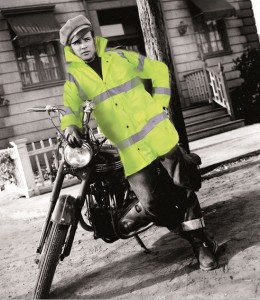 Contributed by Declan McGuire, Blindingly obvious? The Mandatory High Viz Solution is another in our series of occasional features.
Contributed by Declan McGuire, Blindingly obvious? The Mandatory High Viz Solution is another in our series of occasional features.
This article originally appeared in the March 2014 issue of Bike Buyers Guide, through which MAG Ireland has been afforded the opportunity to explore some of the challenges facing riders today.
If a bat and a ball cost €1.10, and the bat costs €1 more than the ball, how much does the ball cost?
Most people, when faced with this question will instinctively answer “ten cents”. It looks and feels like the right answer. Yet it’s wrong. In fact, if you stop to think about it, it’s clearly wrong.
This is the trouble with assumptions. They can be very seductive. Indeed it is often said that for every complex problem, there is a solution that is simple, elegant and wrong.
Motorcycle safety is a complex problem, and one of the solutions proposed by the RSA is mandatory high visibility clothing for riders and pillions. A seductively simple solution but does it stand up to scrutiny?
 To be clear – Irish riders are already subject to mandatory high visibility clothing. The only reason you haven’t noticed is that wearing the L tabard applies only to learner riders, and let’s face it, as long as it’s not directly affecting those of us who’ve long since passed our test we’re not inclined to pay too much attention, right?
To be clear – Irish riders are already subject to mandatory high visibility clothing. The only reason you haven’t noticed is that wearing the L tabard applies only to learner riders, and let’s face it, as long as it’s not directly affecting those of us who’ve long since passed our test we’re not inclined to pay too much attention, right?
That’s why it will also likely have escaped your notice that as part of the imaginatively titled “Road Traffic Bill No.2, 2013”, provisions are to be introduced to extend the wearing of a mandatory high visibility “N” tabard to novice riders. According to the act, you’ll only ever be a novice road user once – the very first time you pass a test in any category – and for two years after passing that first test you’ll carry an “N” plate. If you’re on two wheels, that means wearing a high visibility tabard with an “N” plate for two years post test.
But would the RSA really seek to extend mandatory high visibility clothing to everyone who rides a motorcycle, including pillions? Let’s examine the evidence.
First there is the RSA’s “National Motorcycle Safety Action Plan, 2010-2014”. In it, the RSA states the following:
“The Motorcycle Safety Action [sic] proposes the introduction of regulations for the mandatory wearing of high visibility upper body clothing with full sleeves for ride [sic] and pillion passenger.”
Secondly, there’s the RSA’s response to our enquiries in September 2011 (since removed from the RSA web site) when they told us that:
“…the RSA intends to seek the introduction of mandatory wearing of hi-vis material by all motorcyclists, in 2014. This will be subject to consultation with motorcyclists and industry on the most appropriate type of hi-vis material and possible solutions.”
The RSA has publicly stated its intention to grow the voluntary wearing rates for high viz from 40% of riders to 75%. A survey carried out by MAG Ireland indicated voluntary wearing rates of approximately 50% but found similar disparities to the RSA study. Yet 91% of riders told us they were against compulsion.
Advertisement – continue reading below
In meetings with MAG Ireland the RSA has suggested that there would be no requirement to make high visibility clothing mandatory for riders if voluntary wearing rates exceeded their 75% target. Regarding casualties, the RSA said in September 2011:
“While other drivers need to pay far greater attention to the presence of motorcyclists on the road, motorcyclists should do all they can to increase their visibility on the roads. This can be done by using daytime running lights and wearing reflective or high visibility material.”
 Hard to argue with that, bar the inherent assumption that a driver who can’t see a 55 watt headlight (because they didn’t bother to look properly) will somehow see a fluorescent vest behind the headlight they’re not looking at.
Hard to argue with that, bar the inherent assumption that a driver who can’t see a 55 watt headlight (because they didn’t bother to look properly) will somehow see a fluorescent vest behind the headlight they’re not looking at.
Now let’s make something else absolutely clear. MAG Ireland is NOT opposed to high visibility clothing per-se, but IS opposed to compulsion. We simply want to retain the choice whether to wear high-viz or not as appropriate to our needs and circumstances. We all accept that there are situations where high visibility clothing may help. This is why voluntary wearing rates are as high as 50%.
So what are the chances of compulsion?
Recall that motorcycle helmets were made mandatory at a time when there was already near universal voluntary compliance. The key difference this time is evidence. Only the truly deluded would claim that helmets did not improve rider safety. Study after study showed that riders wearing helmets had better accident outcomes than those without.
 We might therefore expect that there’s ample evidence to suggest that riders who wear high visibility clothing are far less likely to be involved in an accident than those who don’t. We might expect that accident studies like the MAIDS report would show clear evidence that wearing high visibility clothing substantially improves your chances of avoiding an accident.
We might therefore expect that there’s ample evidence to suggest that riders who wear high visibility clothing are far less likely to be involved in an accident than those who don’t. We might expect that accident studies like the MAIDS report would show clear evidence that wearing high visibility clothing substantially improves your chances of avoiding an accident.
Well, no. In fact, when we look at the root causes of motorcycle accidents, and in particular the “right of way violation” accidents, it is clear that in every case the motorcycle was there to be seen had the driver bothered to look properly. High visibility clothing remains invisible to anyone who is not looking.
 In the Irish context, the RSA tell us that three out of four motorcycle accidents involve another vehicle. It’s safe to say then, that high visibility clothing will have no measurable effect on the one in four where the rider alone is responsible for their fate.
In the Irish context, the RSA tell us that three out of four motorcycle accidents involve another vehicle. It’s safe to say then, that high visibility clothing will have no measurable effect on the one in four where the rider alone is responsible for their fate.
The RSA’s own figures also tell us that as many as one in four collisions may be the result of distracted driving, typically when drivers are using the phone. Again, it’s highly unlikely that high visibility clothing would have any effect on this number and we can be fairly certain that the motorcyclist is not the one doing the texting.
MAG Ireland has repeatedly requested that the RSA supply the evidence on which it decided that high viz should be mandatory. To date they have failed to do so. What’s needed then is a proper study, not a knee jerk reaction that blames us riders for the failure of drivers to look properly. Just because mandatory high viz may appear to be the obvious solution doesn’t mean that it is.
That ball? It cost 5 cent. The bat is €1.05 so that together they cost €1.10. That’s the trouble with assumptions. Sometimes the apparently obvious answer is the wrong one.
Like this? See our list of feature articles: https://www.magireland.org/category/features/
